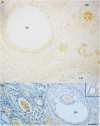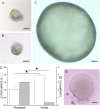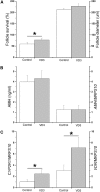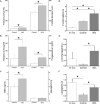Vitamin D3 Regulates Follicular Development and Intrafollicular Vitamin D Biosynthesis and Signaling in the Primate Ovary
- PMID: 30487754
- PMCID: PMC6246691
- DOI: 10.3389/fphys.2018.01600
Vitamin D3 Regulates Follicular Development and Intrafollicular Vitamin D Biosynthesis and Signaling in the Primate Ovary
Abstract
There is an increasing recognition that vitamin D plays important roles in female reproduction. Recent studies demonstrated that 1α,25-dihydroxyvitamin D3 (VD3), the biologically active form of vitamin D, improved ovarian follicle survival and growth in vitro. Therefore, we investigated the direct effects of VD3 at the specific preantral and antral stages of follicular development, and tested the hypothesis that vitamin D receptor (VDR) and enzymes critical for vitamin D biosynthesis are expressed in the primate ovary. Fourteen adult rhesus macaques provided ovarian tissue. Secondary and antral follicles were isolated for PCR analysis on VDR, vitamin D3 25-hydroxylase, and 25-hydroxyvitamin D3-1α-hydroxylase. VDR protein localization was determined by immunohistochemistry on ovarian sections. Isolated secondary follicles were cultured under conditions of control and VD3 supplementation during the preantral or antral stage. Follicle survival, growth, steroid and anti-Müllerian hormone (AMH) production, as well as oocyte maturation were evaluated. In vivo- and in vitro-developed follicles were also assessed for genes that are critical for vitamin D biosynthesis and signaling, gonadotropin signaling, steroid and paracrine factor production, and oocyte quality. The mRNA encoding VDR, 25-hydroxylase, and 1α-hydroxylase was detectable in in vivo- and in vitro-developed preantral and antral follicles. The 25-hydroxylase was elevated in cultured follicles relative to in vivo-developed follicles, which further increased following VD3 exposure. VD3 treatment increased 1α-hydroxylase in in vitro-developed antral follicles. The absence of VD3 during culture decreased VDR expression in in vitro-developed antral follicles, which was restored to levels comparable to those of in vivo-developed antral follicles by VD3 supplementation. Positive immunostaining for VDR was detected in the nucleus and cytoplasm of granulosa cells and oocytes. While only survival was improved in preantral follicles treated with VD3, VD3 supplementation promoted both survival and growth of antral follicles with increased estradiol and AMH production, as well as oocyte maturation. Thus, Vitamin D biosynthesis and signaling systems are expressed in primate ovarian follicles. Our findings support a role for VD3 in regulating follicular development in a stage-dependent manner, as well as the intrafollicular vitamin D biosynthesis and signaling, directly in the ovary.
Keywords: 1α; 1α-hydroxylase; 25-dihydroxyvitamin D3; 25-hydroxylase; 25-hydroxyvitamin D3; rhesus macaque; vitamin D receptor.
Figures




Similar articles
-
Direct vitamin D3 actions on rhesus macaque follicles in three-dimensional culture: assessment of follicle survival, growth, steroid, and antimüllerian hormone production.Fertil Steril. 2016 Dec;106(7):1815-1820.e1. doi: 10.1016/j.fertnstert.2016.08.037. Epub 2016 Sep 24. Fertil Steril. 2016. PMID: 27678030 Free PMC article.
-
Impact of vitamin D3 supplementation on the in vitro growth of mouse preantral follicles.Clin Exp Reprod Med. 2021 Dec;48(4):347-351. doi: 10.5653/cerm.2021.04735. Epub 2021 Nov 23. Clin Exp Reprod Med. 2021. PMID: 34875741 Free PMC article.
-
Matrix-free 3D culture supports human follicular development from the unilaminar to the antral stage in vitro yielding morphologically normal metaphase II oocytes.Hum Reprod. 2021 Apr 20;36(5):1326-1338. doi: 10.1093/humrep/deab003. Hum Reprod. 2021. PMID: 33681988 Free PMC article.
-
Review: Roles of follicle-stimulating hormone in preantral folliculogenesis of domestic animals: what can we learn from model species and where do we go from here?Animal. 2023 May;17 Suppl 1:100743. doi: 10.1016/j.animal.2023.100743. Animal. 2023. PMID: 37567683 Review.
-
[Human folliculogenesis and local regulation].Nihon Sanka Fujinka Gakkai Zasshi. 1995 Aug;47(8):726-37. Nihon Sanka Fujinka Gakkai Zasshi. 1995. PMID: 7594882 Review. Japanese.
Cited by
-
Relationship between Serum 25-Hydroxyvitamin D Levels and Hormonal Status in Infertile Women: A Retrospective Study.Diagnostics (Basel). 2023 Sep 22;13(19):3024. doi: 10.3390/diagnostics13193024. Diagnostics (Basel). 2023. PMID: 37835767 Free PMC article.
-
Immunomodulatory Effects of Vitamin D in Pregnancy and Beyond.Front Immunol. 2019 Nov 22;10:2739. doi: 10.3389/fimmu.2019.02739. eCollection 2019. Front Immunol. 2019. PMID: 31824513 Free PMC article. Review.
-
Proteome changes of porcine follicular fluid during follicle development.J Anim Sci Biotechnol. 2019 Dec 10;10:94. doi: 10.1186/s40104-019-0400-3. eCollection 2019. J Anim Sci Biotechnol. 2019. PMID: 31827787 Free PMC article.
-
Comparative Analysis of Porcine Follicular Fluid Proteomes of Small and Large Ovarian Follicles.Biology (Basel). 2020 May 17;9(5):101. doi: 10.3390/biology9050101. Biology (Basel). 2020. PMID: 32429601 Free PMC article.
-
Effects of supraphysiological vitamin D3 (cholecalciferol) supplement on normal adult rat ovarian functions.Histochem Cell Biol. 2021 Jun;155(6):655-668. doi: 10.1007/s00418-021-01975-0. Epub 2021 Feb 27. Histochem Cell Biol. 2021. PMID: 33641022
References
-
- Bidman H. J., Radu I., Stumpf W. E. (1997). Aspects of 1,25-dihydroxyvitamin D3 binding sites in fish: an autoradiographic study. Rom. J. Morphol. Embryol. 43 91–101. - PubMed
-
- Bièche I., Narjoz C., Asselah T., Vacher S., Marcellin P., Lidereau R., et al. (2007). Reverse transcriptase-PCR quantification of mRNA levels from cytochrome (CYP)1, CYP2 and CYP3 families in 22 different human tissues. Pharmacogenet. Genomics 17 731–742. 10.1097/FPC.0b013e32810f2e58 - DOI - PubMed
Grants and funding
LinkOut - more resources
Full Text Sources

